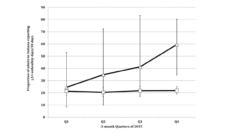Getting older has its challenges. For those in the lesbian, gay, bisexual, transgender, and queer (LGBTQ+) community, it’s even more complicated, especially when it comes to accessing affirming health care and aging services. Fortunately, recent changes to the federal Older Americans Act (OAA) might help this rapidly growing population.
In 1973, the OAA required states to designate local agencies of aging to assist older adults (60+) with accessing senior benefit programs and social services (e.g., care management, outreach, transportation) Thanks to the 2020 reauthorization of the OAA and updated guidance from the federal Administration for Community Living, these agencies must now do so in a way that is LGBTQ+ inclusive.
Having adequate access to resources is one of the best indicators of good health, yet, several barriers make it especially difficult for LGBTQ+ older adults to obtain. For example, many health care policies prioritize biological family members, which increases isolation and loneliness for LGBTQ+ elders who rely on friends and families of choice. Because LGBTQ+ elders are twice as likely to live alone and four times as likely to be childless than their cisgender and heterosexual peers, there are fewer built-in caretaker options.
Additionally, location is a factor in accessing inclusive care. Rural areas, particularly in the South, have been found to have fewer LGBTQ+ specific resources than cities and suburbs in the region. Fear of discrimination and internalized stigma also cause elders to avoid routine checkups and health screenings, which further exacerbates their documented health disparities (e.g., higher rates of chronic disease and disability).
The goal of these new requirements is to improve LGBTQ+ elder health outcomes by removing barriers to ensure these older adults are getting the care they need.
Under the new OAA guidance, state and local departments of aging are required to collect data on the needs of LGBTQ+ elders and report to Congress whether or not those needs have been met. Research on the long-term health outcomes of this population is limited. So this new mandate is an effort to help policymakers determine if care services are effective and equitably available nationwide.
Departments of aging must also share an annual summary with Congress of their targeted outreach activities to LGBTQ+ seniors (e.g., user-friendly consumer information, public education materials). This will help policymakers track whether partnerships with LGBTQ+ communities were successfully developed and hold states accountable.
If a department of aging does not comply with these two requirements, a portion of their federal funding may be withheld. And they will be closely monitored by the federal Assistant Secretary of Aging until their activities do meet the new criteria.
The goal of these new requirements is to improve LGBTQ+ elder health outcomes by removing barriers to ensure these older adults are getting the care they need. While it’s too soon to say if that’s happening yet, similar policy changes have had positive effects in the past.
For example, the Civil Rights Act relied on data collection and outreach to racially integrate hospitals in the 1960s. Investigators appointed by President Johnson reached out to staff and patients to evaluate if hospitals were equitably providing care. Medicare funding was withheld from hospitals that had not fully integrated or had not equally distributed resources by race. This ultimately forced hospitals to improve care for people of color.
The 1996 amended Safe Drinking Water Act took a similar approach to improve health-based standards for drinking water. States were required to work with water suppliers and tribes to assess their water sources and inform the public on their findings. Additional funding was provided to communities that actively protected their water from contaminants. Despite some of the challenges that emerged (e.g., lack of adequate funding, slow movement by states, private well ownerships, etc.), more than 90% of Americans now get their tap water from community water systems that are federally regulated to meet these standards.
The recent OAA reauthorization has the potential to improve health outcomes for LGBTQ+ elders. At a minimum, it will certainly deepen the LGBTQ+ elder community’s ties to aging resources and give policymakers better insight into their specific health and social needs.
Photo via Getty Images















